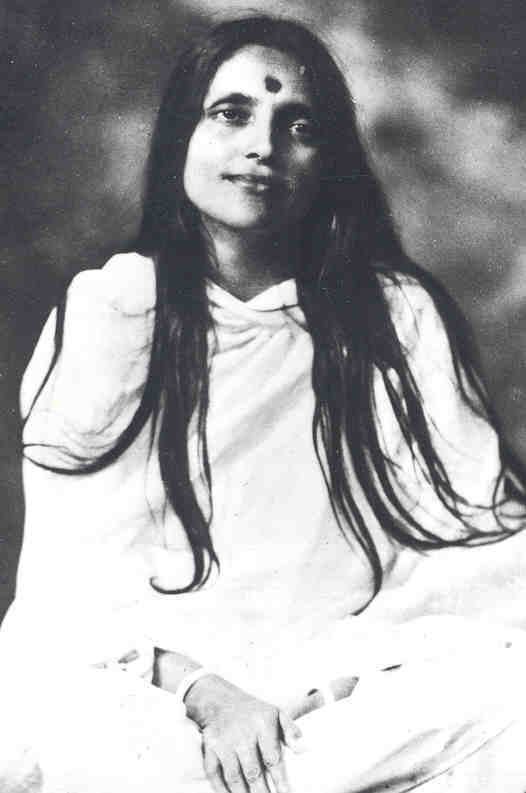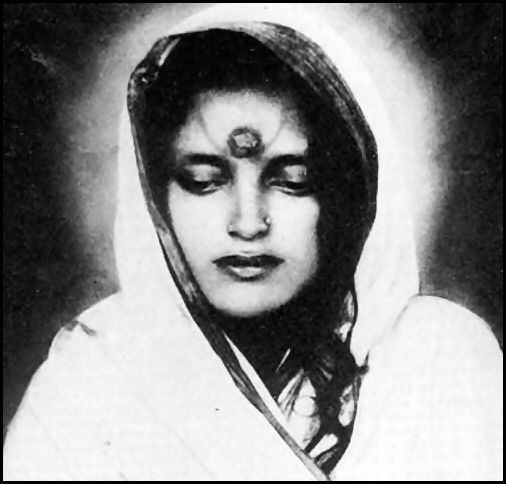Name Anandamayi Ma | ||
 | ||
Quotation "Who is it that loves and who that suffers? He alone stages a play with Himself; who exists save Him? The individual suffers because he perceives duality. It is duality which causes all sorrow and grief. Find the One everywhere and in everything and there will be an end to pain and suffering." Books The Essential Sri Anandamayi Ma: Life and Teachings of a 20th Century Indian Saint Similar Paramahansa Yogananda, Mahavatar Babaji, Neem Karoli Baba | ||
Documentary on the life of sri sri anandamayi ma
Anandamayi Ma (30 April 1896 – 27 August 1982) was an Indian (from Bengal) spiritual leader. Sivananda Saraswati of the Divine Life Society described her as "the most perfect flower the Indian soil has produced." Precognition, faith healing and other miracles were attributed to her by her followers. Paramhansa Yogananda translates Anandamayi as "joy-permeated". This name was given to her by her devotees in the 1920s to describe what they saw as her habitual state of divine joy and bliss.
Contents
- Documentary on the life of sri sri anandamayi ma
- Sri anandamayi ma hari hari her words 1896 1982 w her real voice
- Early life
- In Dhaka
- Death
- Teachings
- References

Sri anandamayi ma hari hari her words 1896 1982 w her real voice
Early life

Anandamayi was born Nirmala Sundari (নির্মলা সুন্দরী; Nirmôla Shundori, English: "Immaculate, Beautiful One") on 30 April 1896 to Bipinbihari Bhattacharya and Mokshada Sundari Devi in Kheora, Brahmanbaria District, British India, in what is now Bangladesh. Her father, originally from Vidyakut in Tripura, was a Vaishnavite singer known for his devotion. They lived in poverty. Nirmala attended the village school for approximately two years. Although her teachers were pleased with her ability, her family had doubts about her mental abilities because of her indifference and constantly happy demeanor. When her mother once fell seriously ill, relatives remarked with puzzlement about the child remaining apparently unaffected.

In 1908 at the age of thirteen, in keeping with the rural custom at the time, she was married to Ramani Mohan Chakrabarti of Vikramapura, whom she would later rename Bholanath. She spent five years after her marriage at her brother-in-law's home, where she was in a withdrawn meditative state much of the time. It was here that a devout neighbor considered insane, Harakumar, developed a habit of addressing her as "Ma", and prostrated before her morning and evening in reverence. When Nirmala was about seventeen, she went to live with her husband in Ashtagram. In 1918, she moved to Bajitpur, where she stayed until 1924. It was a celibate marriage—whenever thoughts of sexuality occurred to Ramani, Nirmala's body would take on the qualities of death. On the full moon night of August 1922, at midnight, twenty-six-year-old Nirmala enacted her own spiritual initiation. She explained that the ceremony and its rites were being revealed to her spontaneously as and when they were called for. She later stated, "As the master (guru) I revealed the mantra; as the disciple (shishya) I accepted it and started to recite it."
In Dhaka

Nirmala moved to Shahbag with her husband in 1924, where he had been appointed caretaker of the gardens of the Nawab of Dhaka. During this period Nirmala went into ecstasies at kirtans. Nirmala continued to perform household tasks, and also continued to practice silence, and was in a withdrawn state of ecstasy much of the time. These states began to interfere with her daily work. In 1926, she set up a Kali temple in the Siddheshwari area and devoted herself to spiritual practices. Nirmala underwent a mystic experience while praying in the temple one day. In a deep meditative state, she held difficult yogic positions for long periods and spontaneously formed complex tantric hand positions and gestures.

During the time in Shahbag, more and more people began to be drawn to what they saw to be a living embodiment of the divine. Jyotiscandra Ray, known as "Bhaiji," was an early and close disciple. He was the first to suggest that Nirmala be called Anandamayi Ma, meaning "Joy Permeated Mother", or "Bliss Permeated Mother". He was chiefly responsible for the first ashram built for Anandamayi Ma in 1929 at Ramna, within the precinct of the Ramna Kali Mandir.
Scholars were attracted to Anandamayi Ma's spirituality and teaching, though she called herself "a little unlettered child". Mahamahopadhyay Gopinath Kaviraj, Sanskrit scholar, philosopher, and principal of Sanskrit College in Kolkata and Triguna Sen were among her early followers. Uday Shankar, the famous dance artist, was impressed by Anandamayi Ma's analysis of dance, which she used as a metaphor for the relationship between people and God. She was a contemporary of the well known Hindu saints like Udiya Baba and Paramahansa Yogananda.
Death
Ma died on 27 August 1982 in Dehradun, and subsequently on 29 August 1982 a Samadhi (shrine) was built in the courtyard of her Kankhal ashram, situated in Haridwar in North India, a shrine was later erected over the samadhi, now known as the Ananda Jyoti Peetham.
Teachings
Anandamayi never prepared discourses, wrote down, or revised what she had said. People had difficulty transcribing her often informal talks because of their conversational speed, further the Bengali manner of alliterative wordplay was often lost in translation. A devotee, Brahmachari Kamal Bhattacharjee, however made attempts to transcribe her speech before audio recording equipment became widely available in India.
A central theme of her teaching is "the supreme calling of every human being is to aspire to self realization. All other obligations are secondary" and "only actions that kindle man's divine nature are worthy of the name of actions". However she did not ask everyone to become a renunciate. "Everyone is right from his own standpoint," she would say. She did not give formal initiations and refused to be called a guru, as she maintained that "all paths are my paths" and kept saying "I have no particular path".
She did not advocate the same method for all. "How can one impose limitations on the infinite by declaring this is the only path—and, why should there be so many different religions and sects? Because through every one of them He gives Himself to Himself, so that each person may advance according to his inborn nature." As she herself has said (ref. Mother Reveals Herself), all forms of sadhana, known and unknown just occurred to her in the form of a lila (play) without any conscious effort on her part. Thus her Sadhana can not be slotted into a specific area, for to do so would mean that she was somehow limited to that area and her mastery was also limited. This was the case as many illustrious spiritual masters and thought leaders from various school of thought be it Shaivaite, Tantric, Vaishnav, or from Islam, Christianity, Zoroastrianism had found in their interactions with her. Everyone was welcome and she was equally at ease while giving advises to all practitioners of different faiths. Even now, the Muslim population of Kheora still refer to her as "our own Ma". She taught how to live a God-centered life in the world and provided the living inspiration to enable thousands to aspire to this most noble ideal. She also advocated spiritual equality for women; for example, she opened up the sacred thread ritual, which had been performed by men only for centuries, to women. Her style of teaching included jokes, songs and instructions on everyday life along with long discourses, meditation and reading of scriptures.
Paramhansa Yogananda wrote about her in his Autobiography of a Yogi. His meeting with her is recounted in the chapter titled "The Bengali 'Joy-Permeated Mother'", where she explains her background:
"Father, there is little to tell." She spread her graceful hands in a deprecatory gesture. "My consciousness has never associated itself with this temporary body. Before I came on this earth, Father, I was the same. As a little girl, I was the same. I grew into womanhood, but still I was the same. When the family in which I had been born made arrangements to have this body married, I was the same... And, Father, in front of you now, I am the same. Ever afterward, though the dance of creation change around me in the hall of eternity, I shall be the same."
The Publication Department of the Shree Shree Anandamayee Charitable Society in Kolkata regularly publishes her teaching in the periodical Anandavarta Quarterly. The Sri Sri Anandamayi Sangha in Haridwar organizes the annual Samyam Mahavrata congregation to devote a week to collective meditation, religious discourse and devotional music.
